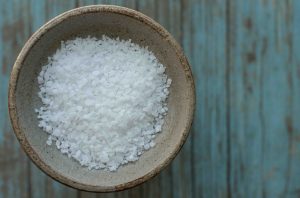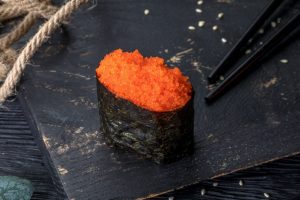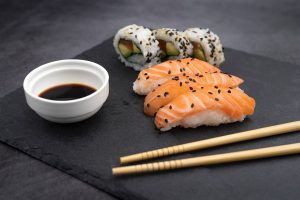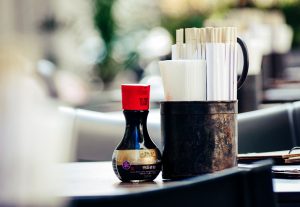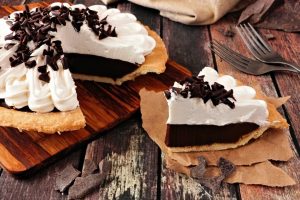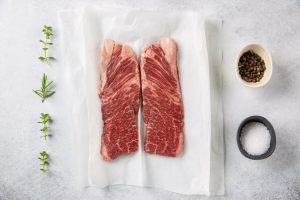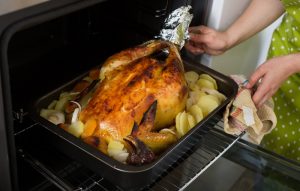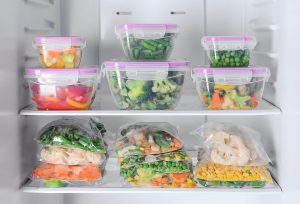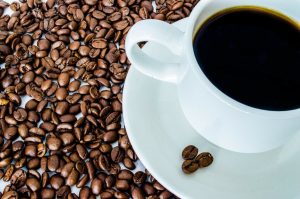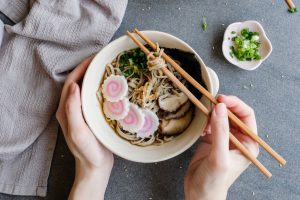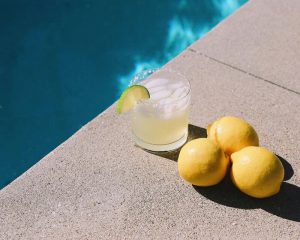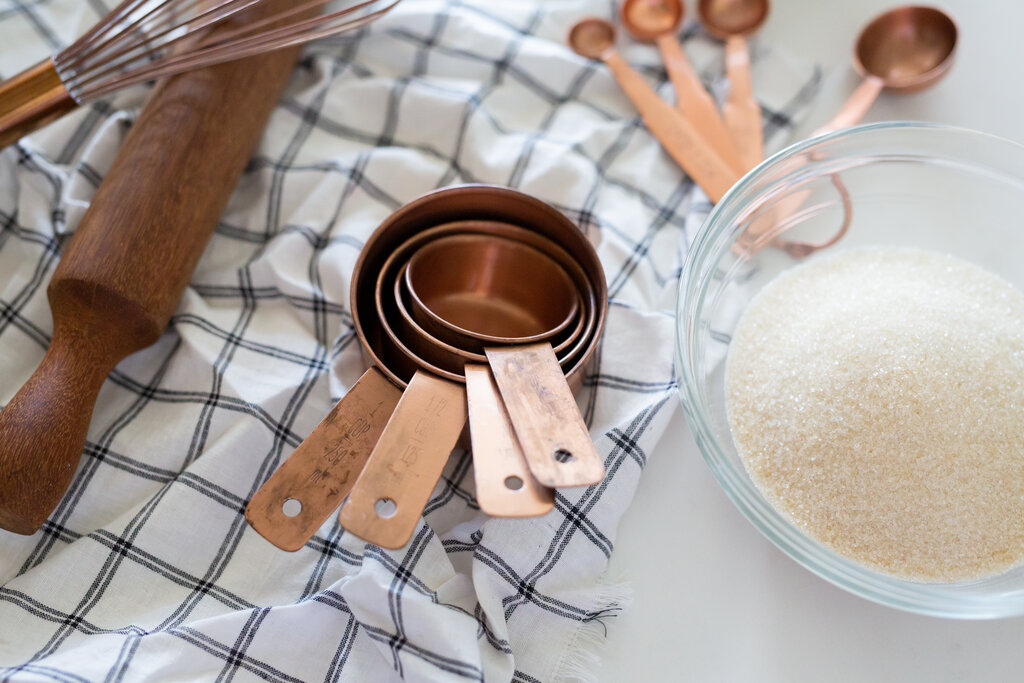
Recreating easy dessert recipes at home can be a breeze if you know how to quickly convert measurements from grams to cups using the tools you have. We all know that precise measurements are important when it comes to baking. And it can be frustrating when recipes ask for ingredients in grams when you only have cup measuring tools in your arsenal! When faced with such a baking woe, you could be left wondering how many grams are in a cup (or vice versa).
In this article, you’ll find handy charts to aid you in converting grams to cups when measuring common baking ingredients. Read more and change from grams to cups and ounces with ease!
Grams to Cups Conversion (For Baking Essentials)
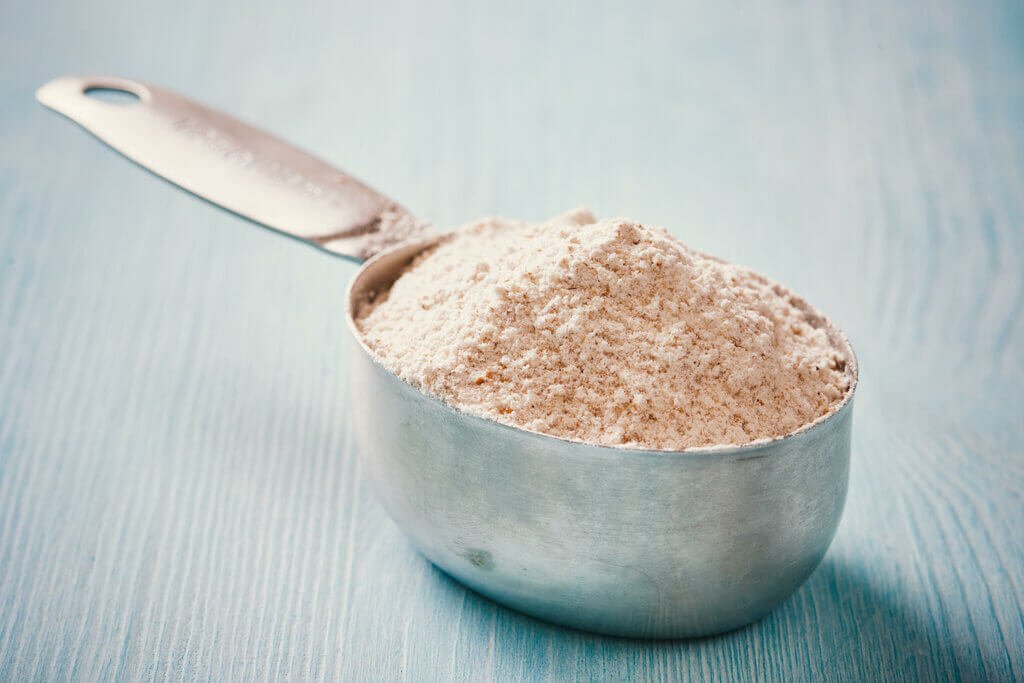
A good rule of thumb in baking is to never guesstimate the measurement of ingredients if you want a perfect result. Estimating can actually lead to a baking catastrophe if you’re not careful.
From flour to honey, precise measurement is a must. Whether you’re baking a big batch of fancy desserts or just want to test your baking skills at home, the grams to cups conversion guides below will guarantee success in the kitchen.
We’ve categorized typical ingredients into groups to easily navigate through your baking needs. From flours and liquid ingredients to sugars and dry goods, everything is measured for you.
Flours or Powders for Baking
All-Purpose Flour, Bread Flour, and Cake Flour
| CUPS | |||
| GRAMS | All-Purpose Flour | Bread Flour | Cake Flour |
| 600 | 4 4/5 | 4 2/3 | 5 1/4 |
| 500 | 4 | 3 3/4 | 4 1/3 |
| 400 | 3 1/5 | 3 1/16 | 3 1/2 |
| 350 | 2 4/5 | 2 2/3 | 3 1/16 |
| 300 | 2 2/5 | 2 1/3 | 2 2/3 |
| 250 | 2 | 1 3/4 | 2 1/4 |
| 200 | 1 3/5 | 1 1/2 | 1 3/4 |
| 150 | 1 1/5 | 1 1/8 | 1 1/3 |
| 100 | 4/5 | 3/4 | 3/4 |
| 80 | 3/5 | 2/3 | 2/3 |
Corn Flour / Cornstarch, Baking Powder, and Cocoa Powder
| CUPS | |||
| GRAMS | Corn Flour / Cornstarch | Baking Powder | Cocoa Powder |
| 600 | 4 3/4 | 2 3/4 | 3 3/4 |
| 500 | 4 | 2 1/3 | 3 1/3 |
| 400 | 3 1/4 | 1 3/4 | 2 2/3 |
| 350 | 2 3/4 | 1 2/3 | 2 1/3 |
| 300 | 2 1/3 | 1 1/3 | 1 3/4 |
| 250 | 2 | 1 1/8 | 1 2/3 |
| 200 | 1 2/3 | 3/4 | 1 1/3 |
| 150 | 1 1/4 | 2/3 | 1 |
| 100 | 3/4 | 1/2 | 2/3 |
| 80 | 2/3 | 1/3 | 1/2 |
Flour is among the essential ingredients in baking, and admittedly, the most mismeasured. Mistakenly converting cake flour from 300 grams to cups might ruin an otherwise perfect bundt. To avoid such a baking disaster, there are tricks for measuring powdery baking ingredients you should note.
One is to use a spoon to scoop flour into the measuring cup instead of scooping straight from the container. Then, with the flat side of a knife or spatula, scrape the excess to level everything out. This tip yields a more accurate result and works with most powdery ingredients.
Another trick, of course, is to refer to our guide above, especially if you’re converting grams to cups to measure different flours, starches, baking powder, and cocoa powder.
READ ALSO: 12 Best Bench Scrapers For Your Baking Needs
Liquid Ingredients for Baking
Water, Milk, Honey/Syrup, and Butter
| CUPS | |||
| GRAMS | Water / Milk | Honey / Syrup | Butter |
| 600 | 2 1/2 | 1 3/4 | 2 3/5 |
| 500 | 2 1/8 | 1 1/2 | 2 1/5 |
| 400 | 1 2/3 | 1 1/4 | 1 4/5 |
| 350 | 1 1/2 | 1 1/16 | 1 1/2 |
| 300 | 1 1/4 | 3/4 | 1 1/3 |
| 250 | 1 1/16 | 3/4 | 1 |
| 200 | 3/4 | 2/3 | 4/5 |
| 150 | 2/3 | 1/2 | 3/5 |
| 100 | 1/2 | 1/3 | 2/5 |
| 80 | 1/3 | 1/4 | 1/3 |
When measuring liquids, it’s best to use a liquid measuring cup — especially for ingredients sold in quarts, pints or gallons. Though using a dry cup to measure liquids yield a close quantity, it must be filled to the brim to be more accurate. So if you are converting milk from 100 grams to cups, you’ll end up spilling it everywhere just to get an exact measurement. A wet cup would be better suited for the task.
Now, making delicious butter buns yourself also requires careful measurements of wet ingredients such as water, butter, and milk. Following our guide above can aid you if you’re following a recipe that uses the metric system of measurement.
Sugars for Baking
Granulated Sugar, Confectioner’s Sugar, and Packed Brown Sugar
| CUPS | |||
| GRAMS | Granulated Sugar | Confectioner’s Sugar | Packed Brown Sugar |
| 600 | 3 | 5 | 3 1/12 |
| 500 | 2 1/2 | 4 1/8 | 2 3/5 |
| 400 | 2 | 3 1/3 | 2 |
| 350 | 1 2/3 | 3 | 1 4/5 |
| 300 | 1 1/2 | 2 1/2 | 1 1/2 |
| 250 | 1 1/4 | 2 1/8 | 1 1/3 |
| 200 | 1 | 1 2/3 | 1 |
| 150 | 2/3 | 1 1/4 | 3/4 |
| 100 | 1/2 | 1 | 1/2 |
| 80 | 1/3 | 2/3 | 2/5 |
Sugars are essential for sweetened baked goods. Following how much a recipe asks for ensures the right taste.
Measuring sugars is a bit more forgiving as you can add more or less to suit your preference. But following the recipe exactly is still imperative as sugars help in the caramelization, texture, and structure of baked goods.
With the guide above, you can be sure that you’re converting grams to cups appropriately.
Dry Goods for Baking
Dry Goods and Rolled Oats
| CUPS | ||
| GRAMS | Dry Goods | Rolled Oats |
| 600 | 4 1/8 | 6 3/4 |
| 500 | 3 1/2 | 5 1/2 |
| 400 | 2 3/4 | 4 1/2 |
| 350 | 2 1/3 | 4 |
| 300 | 2 1/16 | 3 1/4 |
| 250 | 1 3/4 | 2 3/4 |
| 200 | 1 1/3 | 2 1/4 |
| 150 | 1 1/16 | 1 3/4 |
| 100 | 2/3 | 1 |
| 80 | 1/2 | 1 |
Ground Almonds and Parmesan Cheese
| CUPS | ||
| GRAMS | Ground Almonds | Parmesan Cheese |
| 600 | 6 | 6 |
| 500 | 5 | 5 |
| 400 | 4 | 4 |
| 350 | 3 1/2 | 3 1/2 |
| 300 | 3 | 3 |
| 250 | 2 1/2 | 2 1/2 |
| 200 | 2 | 2 |
| 150 | 1 1/2 | 1 1/2 |
| 100 | 1 | 1 |
| 80 | 1 | 1 |
Similar to dry ingredients, measuring goods such as raisins, fresh or dried fruits, oats, nuts, and chocolate chips using a dry cup or measuring spoon is recommended.
When it comes to these ingredients, however, getting exact cup measurements can be quite tricky. You need to consider factors like the density of the goods and whether they’re finely ground or whole.
Regardless, the chart above will give you a rough idea of what you need for a grams to cups conversion.
Cups to Grams to Ounces Conversion (For Baking Ingredients)
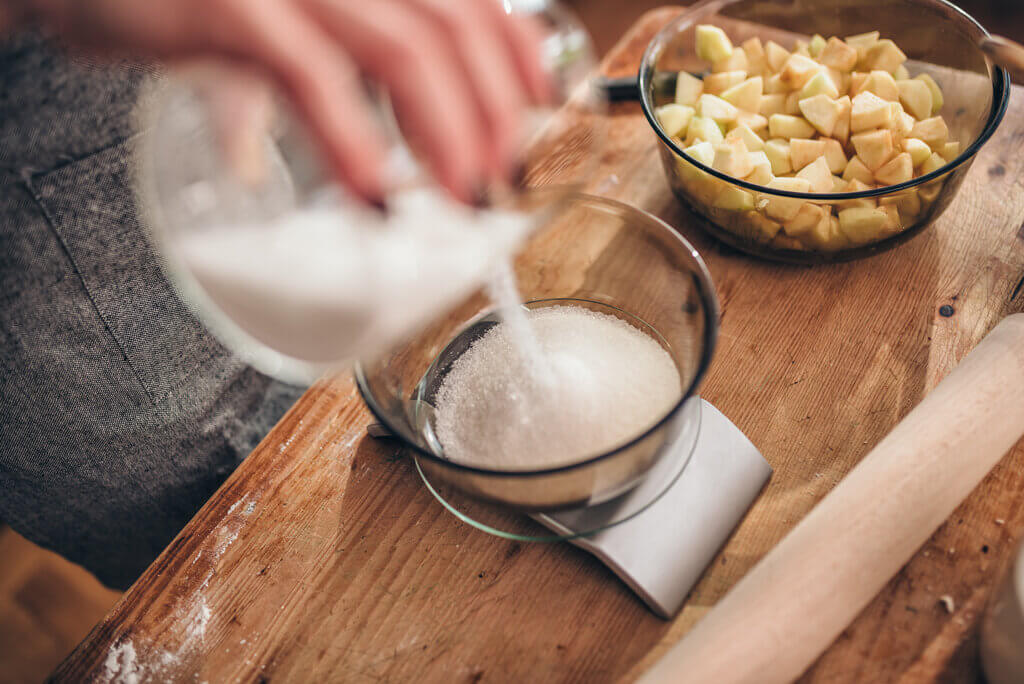
On the other hand, if you need to convert measurements the other way around (from cups to grams), below are charts that will provide you the values you need. Do note that cup measurements aren’t as precise as weight measurements. So, you’ll notice slight fluctuations in values as you convert cups to grams and ounces. Also, measurements can differ when rounded up or down.
All-Purpose Flour
| CUPS (c) | GRAMS (g) | OUNCE (oz) |
| 1 cup | 125 g | 4.4 oz |
| 3/4 cup | 94 g | 3.3 oz |
| 2/3 cup | 83 g | 2.9 oz |
| 1/2 cup | 63 g | 2.2 oz |
| 1/3 cup | 42 g | 1.5 oz |
| 1/4 cup | 31 g | 1.1 oz |
| 1/8 cup (2 tbsp) | 16 g | 0.6 oz |
Referring to the guide, you can note that 1 cup of all-purpose flour weighs 125 grams, provided it is accurately measured. Another tip is to check the recipe whether they measured sifted or unsifted flour.
Typically, flour is passed through a sieve or a flour sifter before measuring to ensure an even level in the cup. This also helps make a smoother mixture and fluffy result afterward.
Bread Flour
| CUPS (c) | GRAMS (g) | OUNCE (oz) |
| 1 cup | 130 g | 4.6 oz |
| 1/2 cup | 65 g | 2.3 oz |
| 1/3 cup | 43 g | 1.5 oz |
| 1/4 cup | 33 g | 1.2 oz |
Incorrect measurement of bread flour can result in a dry and dense baked good. Now, the most accurate way to measure this ingredient is by using a kitchen scale. However, if you don’t have one at home you can still ensure a great product by referring to the table above.
Remember that 1 cup of bread flour is equivalent to 130 grams or 4.6 ounces. Meanwhile, if a recipe needs ¼ cup of bread flour, add 33 grams of this ingredient.
READ ALSO: High Gluten Flour for Baking Bread: Is It Better Than Other Types of Flour?
Cake Flour
| CUPS (c) | GRAMS (g) | OUNCE (oz) |
| 1 cup | 114 g | 4 oz |
| 7/8 cup | 100 g | 3.5 oz |
| 3/4 cup | 86 g | 3 oz |
| 2/3 cup | 76 g | 2.7 oz |
| 5/8 cup | 71 g | 2.5 oz |
| 1/2 cup | 57 g | 2 oz |
| 3/8 cup | 43 g | 1.5 oz |
| 1/3 cup | 38 g | 1.3 oz |
| 1/4 cup | 29 g | 1 oz |
| 1/8 cup | 14 g | 0.5 oz |
A delectable pound cake will always have the right consistency, provided you measure each ingredient accurately, including the cake flour.
For this baking ingredient, remember that 1 cup can hold 114 grams of cake flour. Meanwhile, 14 grams of cake flour is equivalent to ⅛ of a cup. Refer to the conversion table for more accurate measurements.
Cornflour/Cornstarch
| CUPS (c) | GRAMS (g) | OUNCE (oz) |
| 1 cup | 125 g | 4.4 oz |
| 1/2 cup | 63 g | 2.2 oz |
| 1/3 cup | 42 g | 1.5 oz |
| 1/4 cup | 31 g | 1.1 oz |
| 1/16 cup (1 tbsp) | 7 g | 0.2 oz |
Corn flour is yet another essential baking ingredient. Thus, it should be measured with utmost precision. Although, it’s a tad bit difficult to get accurate measurements, especially if you don’t have a kitchen scale on hand. To make things easier for you, look at the table to convert grams to cups and vice versa.
Note that corn flour and cornstarch shouldn’t be interchanged due to their different functions in cooking. So, see what the recipe is asking for to avoid starting from scratch.
READ ALSO: Tapioca Flour vs. Tapioca Starch and Their Best Substitutes
Baking Powder
| CUPS (c) | GRAMS (g) |
| 1 cup | 212 g |
| 3/4 cup | 160 g |
| 2/3 cup | 140 g |
| 1/2 cup | 106 g |
| 1/3 cup | 70.7 g |
| 1/4 cup | 53 g |
| 1/8 cup | 27 g |
| 1/16 cup (1 tbsp) | 13 g |
Most recipes call for baking powder like in this delish blueberry muffin. Though some only need a small amount of this ingredient, an accurate measurement is still imperative.
As shown above, 1 cup of baking powder is about 212 grams. On the other hand, 13 grams is tantamount to 1/16 of a cup. Refer to the chart for more conversion tips in case you need to know its equivalent measurement in grams or cups.
Granulated Sugar
| CUPS (c) | GRAMS (g) | OUNCE (oz) |
| 1 cup | 200 g | 7.1 oz |
| 3/4 cup | 151 g | 5.3 oz |
| 2/3 cup | 133 g | 4.7 oz |
| 1/2 cup | 100 g | 3.5 oz |
| 1/3 cup | 66 g | 2.3 oz |
| 1/4 cup | 50 g | 1.8 oz |
| 1/8 cup (2 tbsp) | 25 g | 0.9 oz |
Granulated sugar, or simply white sugar, has other functions in baking aside from lending its sweetness to recipes. Sugar, along with other staples, also contributes to the structure and texture of baked goods. That said, proper measurement is also required.
If the recipe calls for 1 cup of white sugar, you can incorporate 200 grams of this ingredient. Check out the conversion chart above if you need to convert sugar from grams to ounces or cups.
Confectioner’s Sugar
| CUPS (c) | GRAMS (g) | OUNCE (oz) |
| 1 cup | 121 g | 4.3 oz |
| 1/2 cup | 60 g | 2.1 oz |
| 1/3 cup | 40 g | 1.4 oz |
| 1/4 cup | 30 g | 1.1 oz |
| 1/16 cup (1 tbsp) | 7 g | 0.2 oz |
Also known as powdered sugar or icing sugar, a confectioner’s sugar refers to any sugar in powdered form. Because of its texture, it’s often used to make icing or frosting for baked goods like a delicious strawberry banana split cake.
Take note that you have to weigh out 121 grams to equal 1 cup of confectioners sugar. Meanwhile, ¼ cup is equivalent to 30 grams or 1.1 ounces. Discover the other measurements when converting this particular ingredient from cups to grams or grams to cups.
Packed Brown Sugar
| CUPS (c) | GRAMS (g) | OUNCE (oz) |
| 1 cup | 213 g | 7.5 oz |
| 1/2 cup | 107 g | 3.8 oz |
| 1/3 cup | 71 g | 2.5 oz |
| 1/4 cup | 53 g | 1.9 oz |
When measuring brown sugar, you have to keep a few things in mind. First off, given its moist texture, you have to scoop it into a dry measuring cup, press it firmly into the cup, and make sure that it levels with the rim. By doing so, the brown sugar would hold the shape of the cup when turned out. Plus, this technique also ensures consistent measurement.
Now, touching on quantities, remember that 1 cup of brown sugar is equal to 213 grams or 7.5 ounces of brown sugar. Furthermore, to equal ½ cup of brown sugar, you need 107 grams or 3.8 ounces of this type of sugar. Refer to the table above to get an accurate measurement.
Butter
| CUPS (c) | GRAMS (g) | OUNCE (oz) |
| 1 cup | 227 g | 8 oz |
| 1/2 cup | 114 g | 4 oz |
| 1/3 cup | 76 g | 2.7 oz |
| 1/4 cup | 57 g | 2 oz |
Generally, butter is usually the easiest to measure, considering how its wrapper already has tablespoon markings. Nonetheless, note that 1 stick of butter measures 8 tablespoons or ½ cup.
On most occasions, you simply have to cut off the amount you need in a recipe. However, if you need to use cup measures or the wrapper doesn’t have the printings on it, check our conversion table to keep things easier for you.
READ ALSO: 15 Top Butter Dishes To Keep Your Butter Fresh
Dry Goods
| CUPS (c) | GRAMS (g) | OUNCE (oz) |
| 1 cup | 145 g | 5.1 oz |
| 3/4 cup | 109 g | 3.8 oz |
| 2/3 cup | 97 g | 3.4oz |
| 1/2 cup | 73 g | 2.6 oz |
| 1/3 cup | 48 g | 1.7 oz |
| 1/4 cup | 36 g | 1.3 oz |
| 1/8 cup (2 tbsp) | 18 g | 0.6 oz |
Keep in mind that if you’re using cup measures, the conversion of dry goods may vary. To put it simply, how you fill the cup matters as the ingredient can either weigh less or more depending on its volume. Take for example the difference in measuring fruits such as blueberries, tomatoes, and cherries. As they have varying densities, weighing them into ounces or grams can fluctuate.
If you need to convert dry goods from cups to grams and ounces, check out our handy conversion chart for guidance.
READ ALSO: How Many Ounces Are in a Pint of Blueberries?
Cocoa Powder
| CUPS (c) | GRAMS (g) | OUNCES (oz) |
| 1 cup | 90 g | 3.25 oz |
| 1/2 cup | 45 g | 1.6 oz |
| 1/3 cup | 30 g | 1.1 oz |
| 1/4 cup | 23 g | 0.8 oz |
| 1/4 cup | 38 g | 1.3 oz |
| 1/16 cup (1 tbsp) | 9 g | 0.3 oz |
Cocoa powder, which is derived from cocoa beans, does chocolatey wonders to baked goods such as in these molten chocolate baby cakes. Much like flour, you have to sift cocoa powder first before measuring it. And when converting grams of cocoa powder to cups, note that 1 cup holds 151 grams of cocoa powder. Refer to the conversion table to find out how many grams of cocoa powder are in a cup.
Rolled Oats
| CUPS (c) | GRAMS (g) | OUNCE (oz) |
| 1 cup | 90 g | 3.25 oz |
| 1/2 cup | 45 g | 1.6 oz |
| 1/3 cup | 30 g | 1.1 oz |
| 1/4 cup | 23 g | 0.8 oz |
Rolled oats provide texture, making them a suitable ingredient for baking. And like most baking foodstuffs, it should be measured precisely as well. To do this, ensure that it’s leveled in a measuring cup first. Only then can you get the proper measurement. Bear in mind that if a recipe requires 1 cup of rolled oats, 90 grams of this ingredient is sufficient. Both are tantamount to 3 ounces of rolled oats. If you need to convert grams to ounces or cups, just refer to our handy chart.
READ ALSO: 8 Types of Oats and Which Is the Best
Ground Almonds
| CUPS (c) | GRAMS (g) | OUNCE (oz) |
| 1 cup | 90 g | 3.17 oz |
| 1/2 cup | 48 g | 1.7 oz |
| 3/8 cup | 36 g | 1.3 oz |
| 1/3 cup | 32 g | 1.13 oz |
| 1/4 cup | 24 g | 0.9 oz |
| 1/8 cup | 12 g | 0.42 oz |
With a distinct crunch to them, almonds are often included in many recipes from desserts to bread. In some cases, a recipe calls for the ground version such as in this apricot oatmeal bars recipe. If a recipe requires a cup of ground almonds, but you prefer measuring it by weight, remember that 90 grams will do for 1 cup. Meanwhile, ⅛ of a cup is a match to 12 grams of this nutty ingredient.
Parmesan (Finely Grated)
| CUPS (c) | GRAMS (g) | OUNCE (oz) |
| 1 cup | 100 | 3.5 oz |
| 1/2 cup | 50 g | 1.8 oz |
| 1/3 cup | 33 g | 1.2 oz |
| 1/4 cup | 25 g | 0.9 oz |
Parmesan, without a doubt, elevates any dish, especially if measured accurately. Yes, you read that right. This cheese, like most baking ingredients, also has to be measured correctly. There are several grate sizes, but for now, we’ll touch on the finely grated Parmesan cheese. When measuring this ingredient using a scale, note that 1 cup is equal to 100 grams. In detail, you can look at the conversion chart for a few more parmesan grams to cups measurements.
Honey and Syrups
| CUPS (c) | GRAMS (g) | OUNCE (oz) |
| 1 cup | 326 g | 11.5 oz |
| 3/4 cup | 245 g | 8.6 oz |
| 2/3 cup | 218 g | 7.7 oz |
| 1/2 cup | 163 g | 5.7 oz |
| 1/3 cup | 109 g | 3.8 oz |
| 1/4 cup | 82 g | 3 oz |
| 1/8 cup (2 tbsp) | 41 g | 1.4 oz |
Measuring honey or syrup can be a bit trickier than you might think, considering they have a viscous consistency. Off the bat, the hack here is to coat the measuring cup with oil or to spray it with a nonstick cooking spray. Aside from easy and accurate measurement, it’ll ease the clean-up as well! Now, when measuring this particular sticky condiment, keep in mind that 1 cup is equivalent to 326 grams or 11.5 ounces. Refer to our conversion chart when you measure honey or syrup.
These Grams to Cups Conversion Guides Help Yield Perfect Results
What sets baking apart from regular cooking is that it requires precise measurement of ingredients. As such, if you’re serious about baking, you should learn how to easily convert the ingredients from grams to cups or cups to grams and ounces. With our convenient conversion tables, the measuring task should be easy for you! Follow our guides to always end up with perfectly delicious baked goods.
